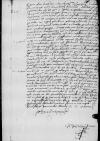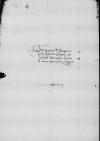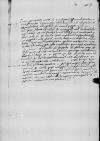[1] The efforts to appoint a coadjutor for Henrich Snellenberg (†1539), son of a Thorn (Toruń) merchant; studied in Cracow, Cologne, Ingolstadt, and Frankfurt an der Oder; from 1499 to his death Canon of Ermland (Warmia) (took the canonry in 1501) (SBKW, p. 226-227; ZINS 1959, p. 431-432)⌊Henrich SnellenbergHenrich Snellenberg (†1539), son of a Thorn (Toruń) merchant; studied in Cracow, Cologne, Ingolstadt, and Frankfurt an der Oder; from 1499 to his death Canon of Ermland (Warmia) (took the canonry in 1501) (SBKW, p. 226-227; ZINS 1959, p. 431-432)⌋ were undertaken due to a serious illness he began to suffer from in June 1537 (cf. Andrzej Kopiczko, Duchowieństwo katolickie diecezji warmińskiej w latach 1525-1821. Część 2 Słownik, Osztyn, 2000 ⌊KOPICZKO 2cf. Andrzej Kopiczko, Duchowieństwo katolickie diecezji warmińskiej w latach 1525-1821. Część 2 Słownik, Osztyn, 2000 ⌋, p. 49; cf. Słownik Biograficzny Kapituły Warmińskiej, ed. by Jan Guzowski, Olsztyn, WSDMW "Hosianum", 1996 ⌊SBKWcf. Słownik Biograficzny Kapituły Warmińskiej, ed. by Jan Guzowski, Olsztyn, WSDMW "Hosianum", 1996 ⌋, p. 227). In the autumn of 1537, Alexander von Suchten (*ca. 1520 – †1576-1590), doctor of medicine, alchemist, poet; studied in Leuven, Ferrara, Rome, Bologna and Padua; as a nephew of Alexander Sculteti, accused of heresy and sentenced in 1545 to lose a canonry and hereditary property; 1538-1545 Canon of Ermland (Warmia); 1549 court physician and librarian of Ottheinrich of Palatinate-Neuburg; 1557 court physician of Sigismund Augustus in Vilnius (PSB 45/3, p. 337-338)⌊Alexander SuchtenAlexander von Suchten (*ca. 1520 – †1576-1590), doctor of medicine, alchemist, poet; studied in Leuven, Ferrara, Rome, Bologna and Padua; as a nephew of Alexander Sculteti, accused of heresy and sentenced in 1545 to lose a canonry and hereditary property; 1538-1545 Canon of Ermland (Warmia); 1549 court physician and librarian of Ottheinrich of Palatinate-Neuburg; 1557 court physician of Sigismund Augustus in Vilnius (PSB 45/3, p. 337-338)⌋, promoted by his uncle Alexander Sculteti (Scholtcze) (*ca. 1485 – †1570), doctor of canon law, cartographer, historian and friend of Copernicus; accused by Dantiscus and Stanisław Hozjusz (Hosius) of Sacramentarian heresy, in 1540 banished by King Sigismund I Jagiellon; in 1541 imprisoned by the Inquisition in Rome; after release from prison in 1544 he stayed in Rome for the rest of his life; 1509-1516 notary at the Roman Curia; 1519-1541 Canon of Ermland (Warmia), 1530-1539 Chancellor of the Ermland Chapter; 1536-1538 administrator of the komornictwo of Mehlsack (Melzak, today Pieniężno) (KOPICZKO 2, p. 299; SBKW, p. 219-220)⌊Alexander ScultetiAlexander Sculteti (Scholtcze) (*ca. 1485 – †1570), doctor of canon law, cartographer, historian and friend of Copernicus; accused by Dantiscus and Stanisław Hozjusz (Hosius) of Sacramentarian heresy, in 1540 banished by King Sigismund I Jagiellon; in 1541 imprisoned by the Inquisition in Rome; after release from prison in 1544 he stayed in Rome for the rest of his life; 1509-1516 notary at the Roman Curia; 1519-1541 Canon of Ermland (Warmia), 1530-1539 Chancellor of the Ermland Chapter; 1536-1538 administrator of the komornictwo of Mehlsack (Melzak, today Pieniężno) (KOPICZKO 2, p. 299; SBKW, p. 219-220)⌋ (cf. cf. Alexander SCULTETI to Ioannes DANTISCUS Frauenburg (Frombork), 1537-09-08, CIDTC IDL 1705⌊IDL 1705cf. Alexander SCULTETI to Ioannes DANTISCUS Frauenburg (Frombork), 1537-09-08, CIDTC IDL 1705⌋), tried unsuccesfully to obtain this office. Eventually, in the spring of 1538, the coadjutorship was given to Dantiscus’ protégé Fabian Wojanowski (Fabian of Dąbrówka, Fabian Damerau) (†1540), courtier of King Sigismund I Jagiellon and Queen Bona Sforza, German tutor to their son Sigismund II Augustus. In 1531 he went back to his family name Damerau; Dantiscus' companion on his mission to Emperor Charles V and his successor as a royal envoy at the Imperial court; 1539-1540 Canon of Ermland (Warmia) (from 1538 coadiutor of Henryk von Snellenberg by Dantiscus' patronage) (KOPICZKO 2, p. 49; SBKW, p. 37)⌊Fabian WojanowskiFabian Wojanowski (Fabian of Dąbrówka, Fabian Damerau) (†1540), courtier of King Sigismund I Jagiellon and Queen Bona Sforza, German tutor to their son Sigismund II Augustus. In 1531 he went back to his family name Damerau; Dantiscus' companion on his mission to Emperor Charles V and his successor as a royal envoy at the Imperial court; 1539-1540 Canon of Ermland (Warmia) (from 1538 coadiutor of Henryk von Snellenberg by Dantiscus' patronage) (KOPICZKO 2, p. 49; SBKW, p. 37)⌋ (cf. Andrzej Kopiczko, Duchowieństwo katolickie diecezji warmińskiej w latach 1525-1821. Część 2 Słownik, Osztyn, 2000 ⌊KOPICZKO 2cf. Andrzej Kopiczko, Duchowieństwo katolickie diecezji warmińskiej w latach 1525-1821. Część 2 Słownik, Osztyn, 2000 ⌋, p. 49, cf. Słownik Biograficzny Kapituły Warmińskiej, ed. by Jan Guzowski, Olsztyn, WSDMW "Hosianum", 1996 ⌊SBKWcf. Słownik Biograficzny Kapituły Warmińskiej, ed. by Jan Guzowski, Olsztyn, WSDMW "Hosianum", 1996 ⌋; p. 37).
[2] ecclesia means here the cathedral church in Frauenburg (Frombork, Varmia, Warmia), town in Ermland, on the Vistula Lagoon, Ermland bishopric see⌊FrauenburgFrauenburg (Frombork, Varmia, Warmia), town in Ermland, on the Vistula Lagoon, Ermland bishopric see⌋.
[3] vestis tabinea - a vestment made of a silk-worsted fabric called tabinet.
[4] Trenck mentions the would-be meeting with Dantiscus in Dietrichswalde (Gietrzwałd), village SE of Allenstein (Olsztyn), roughly halfway between Löbau (Lubawa) and Heilsberg (Lidzbark Warmiński)⌊Dietrichswalde (Gietrzwałd)Dietrichswalde (Gietrzwałd), village SE of Allenstein (Olsztyn), roughly halfway between Löbau (Lubawa) and Heilsberg (Lidzbark Warmiński)⌋ in one of his letters (cf. cf. Achatius TRENCK to Ioannes DANTISCUS Allenstein (Olsztyn), 1538-02-16, CIDTC IDL 3621⌊IDL 3621cf. Achatius TRENCK to Ioannes DANTISCUS Allenstein (Olsztyn), 1538-02-16, CIDTC IDL 3621⌋).
[5] Dantiscus and Giese await for their preconizations.
[6] gentiles nostri, literally 'our fellow countrymen', here refers to the Gdańsk (Danzig) town council.
[7] after quod a mark of correction, but there is no correction – leaf cut at top
[8] aurum Hornense - a low-value gold coin minted by Jan van Horne (Jean de Hornes) (*ca. 1450 – †1505), 1485-1505 Bishop of Liège ⌊Jan van HorneJan van Horne (Jean de Hornes) (*ca. 1450 – †1505), 1485-1505 Bishop of Liège ⌋, Bishop of Liège in 1485-1505 (cf. Het kasboek van Henricus Lontzenius, de laatste abt van het klooster Selwerd, over de jaren 1560-1563, ed. by F.J. Bakker, Renée Nip, E. Schut, Assen, Uitgeverij Van Gorcum, 2003 ⌊Het kasboekcf. Het kasboek van Henricus Lontzenius, de laatste abt van het klooster Selwerd, over de jaren 1560-1563, ed. by F.J. Bakker, Renée Nip, E. Schut, Assen, Uitgeverij Van Gorcum, 2003 ⌋, p. 27).
[9] In his cf. Ioannes DANTISCUS to UNKNOWN Löbau (Lubawa), 1538-02-03, CIDTC IDL 4348⌊lettercf. Ioannes DANTISCUS to UNKNOWN Löbau (Lubawa), 1538-02-03, CIDTC IDL 4348⌋ to an unknown addressee from 1538-02-03, Dantiscus mentioned the sum of three thousand marck (Polish grzywna)that the ⌊Gdańsk Town Council⌋ owed the bishop of Kulm (Chełmno) and the division of interests between the Bishop and the Kulm Chapter ⌊Kulm ChapterKulm Chapter ⌋.
[10] In the cf. Tiedemann GIESE to Ioannes DANTISCUS Frauenburg (Frombork), 1538-03-08, CIDTC IDL 4747⌊replycf. Tiedemann GIESE to Ioannes DANTISCUS Frauenburg (Frombork), 1538-03-08, CIDTC IDL 4747⌋ to this letter, Giese wrote that at the beginning of October (of the previous year) his brother had already received three thousand marcae (Polish grzywna) from the Gdańsk Town Council ⌊Gdańsk Town CouncilGdańsk Town Council ⌋ and that they still had to pay the dues for two and a half months.
 BCz, 245, p. [1] missed in numbering after p. 8
BCz, 245, p. [1] missed in numbering after p. 8


